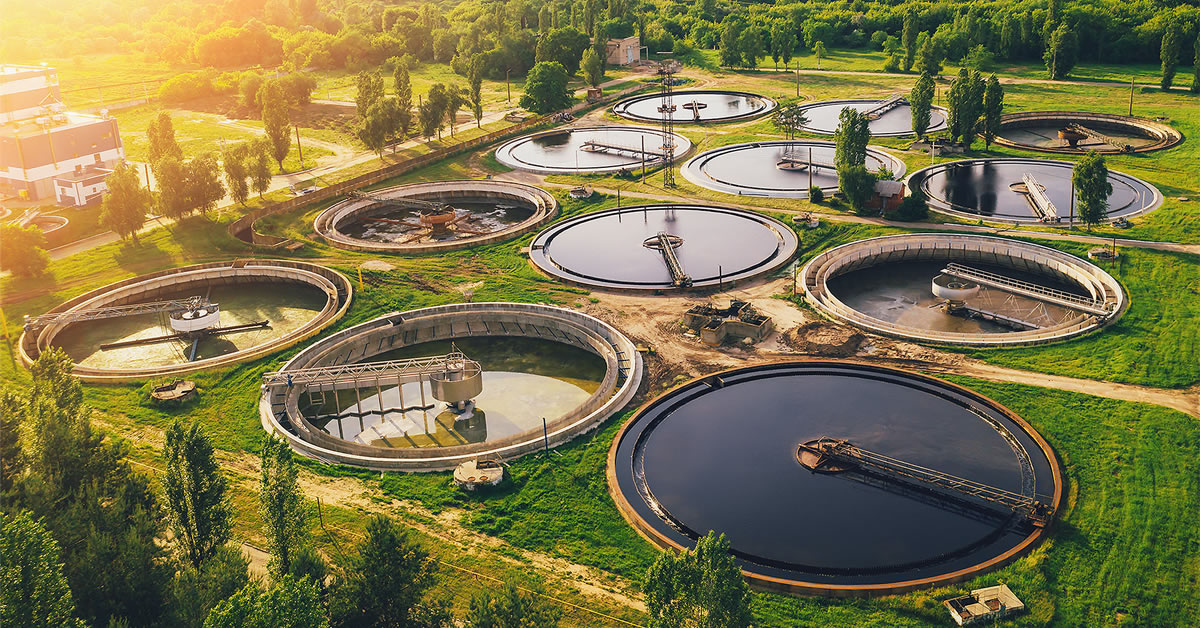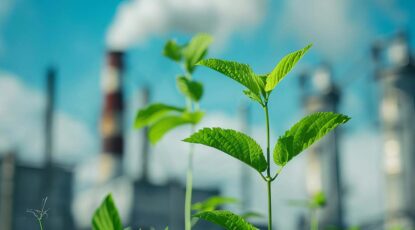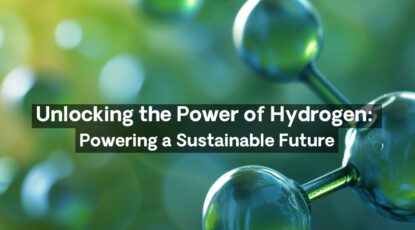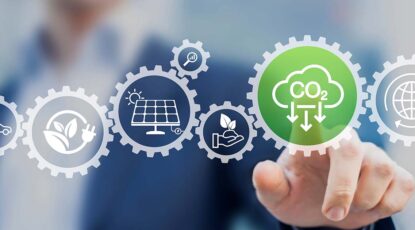What is Biogas?
When organic matter, such as food, agriculture, and human and animal waste (an example cited often is cow waste) decomposes in an anaerobic environment (without any oxygen) it releases a blend of greenhouse gases, primarily methane and carbon dioxide (CO2). Biogas contains roughly 50-70 percent methane and 30-40 percent carbon dioxide with trace amounts of other gases. Methane (CH4) is a powerful greenhouse gas that traps heat in the atmosphere more efficiently than carbon dioxide.
It is estimated that the US alone produces more than 70 million tons of organic waste each year, posing significant risk to the environment and public health. However, this organic waste challenge also represents a massive opportunity to accelerate toward a lower carbon future.
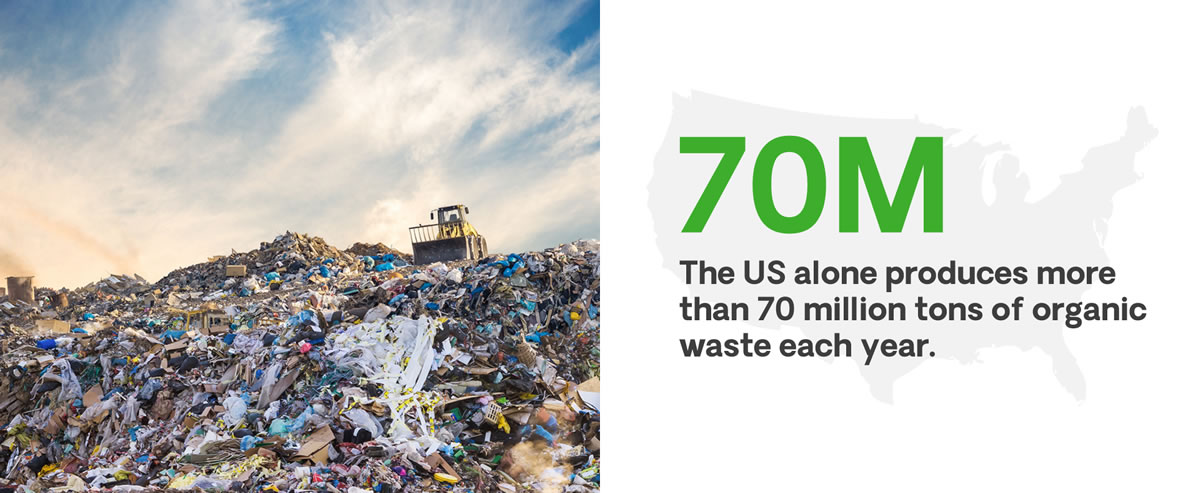
When released into the atmosphere, these greenhouse gases accelerate global warming. Fortunately, this biogas can be captured and utilized as zero-carbon fuel, while destroying the methane in the process. Waste that would otherwise contribute toward global warming as atmospheric greenhouse gases presents a significant opportunity to be a key driver of the world’s de-carbonization strategy.
What is Methane and Why Does Methane Matter?
Organic waste generates large amounts of methane as it decomposes anaerobically. With a global warming potential more than 25 times greater than CO2 and a short (12-year) atmospheric life, methane is a potent greenhouse gas that is a key contributor to global climate change.
Most of the methane from waste processing is vented to the environment, flared, or burned to generate electricity through combustion engines – all three of which negatively impact both public health and the environment. The alternative involves significantly pre-treating the biogas to convert it into Renewable Natural Gas (RNG) before transporting as compressed gas or inserting into the natural gas pipeline, which is a costly process.
What is the Difference Between Biogas and Renewable Natural Gas (RNG)?
Raw biogas contains contaminants that are incompatible with modern engines and not suitable for injection into the natural gas pipeline. Biogas must be “cleaned up” in order to be used as a fuel in common applications.
When biogas is upgraded to pipeline-quality natural gas, the resulting RNG is utilized for natural gas-powered equipment and vehicles, injection into the natural gas pipeline, or generating electricity on site. While RNG used in this way lowers carbon emissions, it typically goes through a combustion-based process to generate heat or electricity – harming local air quality with particulate emissions, nitrogen oxides, and sulfur oxides that are hazardous for human health.
How is Biogas Used?
Captured biogas with no treatment or minimal treatment can be used to produce heat or electricity in fuel cells, engines, and microturbines. This electricity can be used onsite or exported into the local grid.
Fuel cells can uniquely generate electricity from biogas at high efficiency and without combustion (emitting near zero local air pollutants), avoiding a large portion of the costly treatment and conditioning process that is required to convert biogas into RNG.
The electricity generated in this way can be used onsite to lower the cost and carbon intensity output of a facility’s operations, while also granting improved resilience against power outages and other power disruptions from the local grid. This is a particularly attractive option for companies and municipalities that run facilities that produce biogas – such as dairies, landfills, and wastewater treatment plants.
Where is biogas produced?
Biogas is produced where there is an abundance of organic waste. Below are three of the larger sources of biogas in the US today.
- Landfill: Landfills are a major source of biogas. Using biogas to generate onsite electricity reduces the need for flaring, improving air quality in surrounding communities. This can also provide an important potential revenue stream for cities, which can help support other waste or sustainability related initiatives.
- Animal and Agriculture: Dairies see biogas as a revenue pathway and clean waste management method. Biogas also prevents waste overflow from the dairies into the ecosystem of the community and helps prevent manure odor. For dairies, biogas is the highest value feedstock available as a fuel source, with the lowest carbon intensity.
- Wastewater Treatment Plant: Biogas production from wastewater treatment facilities is inevitable and should be expected to increase with population. Additionally, WWT plants collectively use 3-4% of the energy consumed in the US, and have a strong need for resilient onsite power solutions. Efficient biogas utilization is top of mind for these facilities as they address both resilience and climate action planning.
Biogas can be efficiently converted into electricity at its source – giving operators a variety of benefits including lowering the cost of power, eliminating power outage risk, and improving sustainability profiles.
Why is Biogas Important?
It’s critical that we diversify away from fossil fuels to meet global energy demand with a sustainable energy source like biogas – an environmentally friendly energy source that solves many environmental, societal, and health problems simultaneously:
- Human waste will continue to increase as population grows, positioning biogas as a sustainable and scalable energy source.
- It helps with the global waste issue that releases dangerous levels of methane gas, dramatically reducing the impact of waste on global warming and climate changeIn the developing world, biogas utilization reduces water borne diseases since sewage and waste can be treated in a proper manner rather than increasing pathogens by simply flowing into water sources.
- Furthering the biogas ecosystem can enable community and rural electricity in the developing world and reduce indoor pollution through applications such as biogas-powered clean cook stoves.
- Farmers, landfill operators, and wastewater treatment facilities gain a combination of energy independence, new sources of income, clean water, and reduced odor.
- Biogas can be a zero-carbon source of power, even reaching negative-carbon in some applications.
How to Achieve Zero-Carbon Power with Biogas
Companies and municipalities can utilize biogas onsite to generate clean electricity. Because biogas enables the generation of electricity utilizing CO2 and methane that otherwise would have existed in the atmosphere as greenhouse gases, it is possible for facilities to reach not only zero-carbon, but negative carbon.
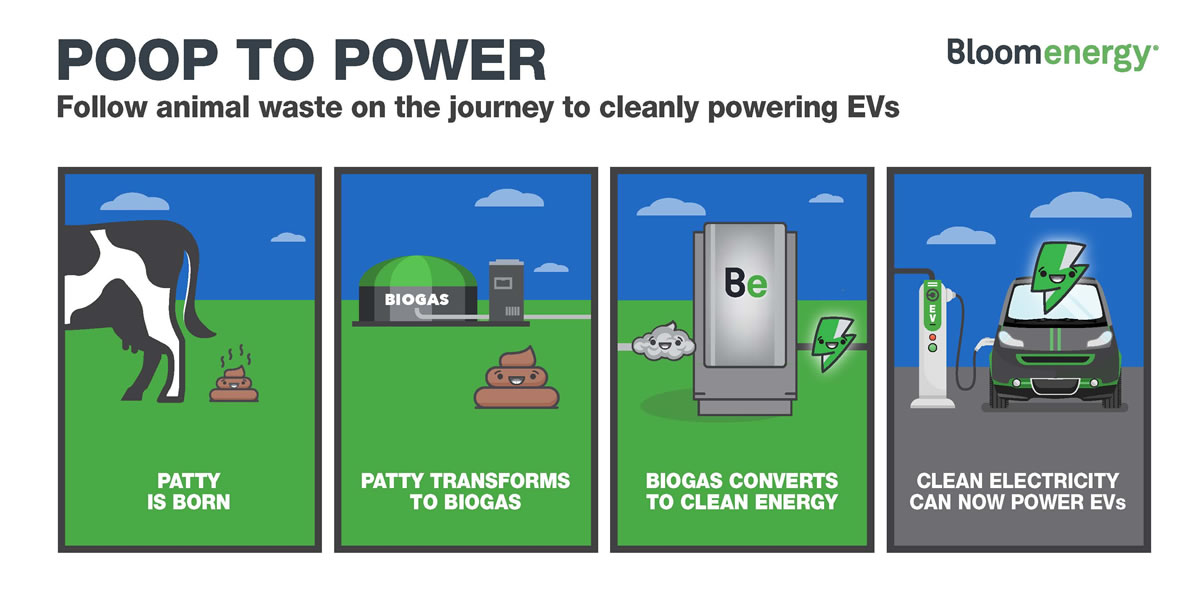
Using a fuel cell to generate electricity from biogas for EV charging is a good example of using a zero-carbon source of power to support a larger electrified and decarbonized ecosystem – instead of EV charging drawing on dirtier grid alternatives such as coal or imported fossil fuels.
If all of the economically viable dairy biogas in California was utilized to generate electricity, it would produce more than 300 megawatts of power. That’s enough to power approximately 600,000 EVs, each traveling 15,000 miles per year.
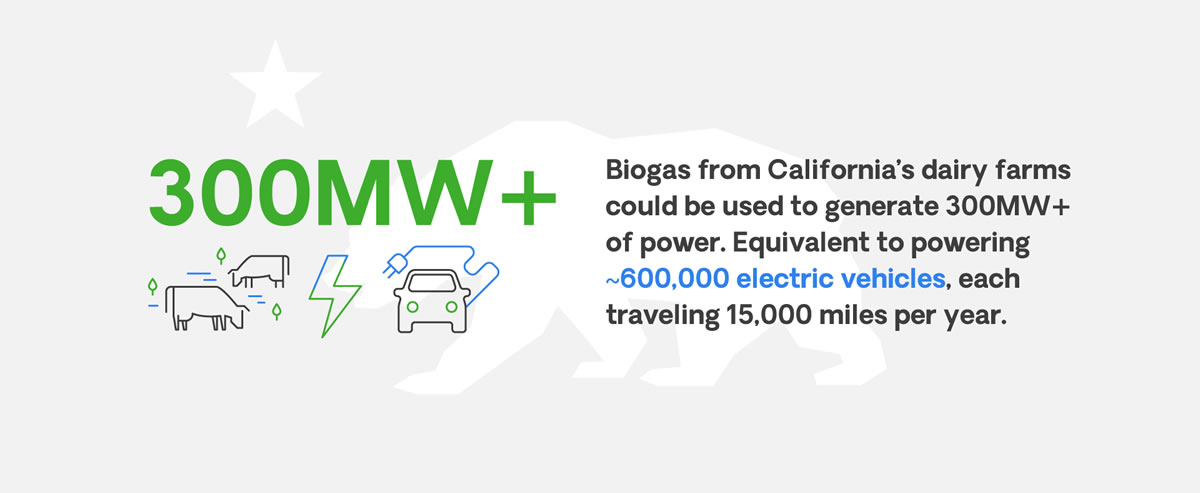
Biogas Powering the Future:
If all of the landfill gas in California were captured and converted into electricity using highly efficient, non-combustion technology such as a Bloom Energy Server, it could power 700,000 homes – roughly a city the size of San Diego. Similarly, New York’s landfill gas has the potential to power the state’s capital, Albany, four times over.
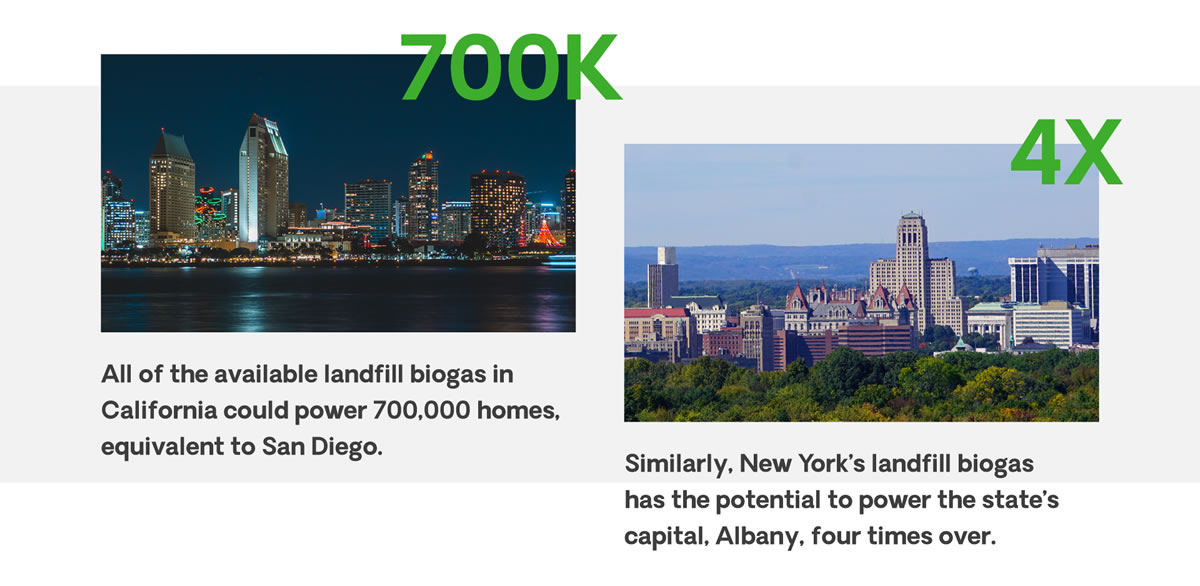
Bloom is deeply engaged with partners to advance biogas as a decarbonization pathway.
- To turn cow waste into renewable electricity, Bar 20 Dairy, a dairy farm in Kerman, California, combined a methane digester, gas clean-up skid, and Bloom Energy fuel cells for an end-to-end, waste-to-electricity solution. Excess power produced is used to charge electric vehicles.
- The California Bioenergy (CalBio) digesters capture biogas, primarily consisting of methane, released from the anaerobic decomposition of dairy manure. After being cleaned, the biogas is then converted to renewable electricity through an electrochemical process, without combustion through Bloom Energy’s fuel flexible, solid oxide fuel cells.
Access to clean, reliable, affordable power is more important than ever in today’s digital age. With biogas, a vision of powering every village and town in the world by utilizing local waste is a sustainable way to empower those communities and improve quality of life.
